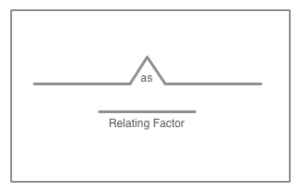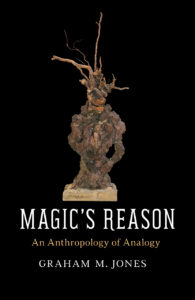“Analogies are hard,” my daughter’s first-grade teacher said to me one morning as we stood in front of the eight thinking maps posted on the wall of the classroom—the tree map for classifying, the circle map for defining in context, the flow map for sequencing, the bubble map for describing, the double bubble map for comparing and contrasting, the brace map for whole-part relations, the multi-flow map for cause and effect, and the bridge map for seeing analogies. I nodded in agreement without pursuing further (as morning drop-offs at an elementary school are not ideal occasions for prolonged interviews and conversations). My ethnographic curiosity, however, was piqued as I learned that these visual-verbal devices are now used in American elementary schools to teach “fundamental thinking processes” or “thinking scientifically.” But what is particularly hard about the bridge map compared to all the other thinking maps? Why is analogy considered both fundamental and challenging? Why are other ways of rational thinking—induction and deduction, for example, which continue to mediate and constrain debates in how anthropology and other sciences should be done—not considered fundamental scientistic thinking?

 Graham Jones’s Magic’s Reason: An Anthropology of Analogy helps answer some of my questions and raises others—as a truly thoughtful and thought-provoking ethnography does. Jones takes his readers on an ethnohistorical journey that traverses instrumental magic (which is mostly occult and “primitive”), stage magic (which aspires to be modern by calling out the trickery and confusion of instrumental magic), and anthropological methodology (which works by analogical comparisons, including the comparisons of various forms of magic as well as between magical and scientistic thinkings) from the mid-nineteenth century onward. In doing so he explicates a set of partial and complex associations within which both stage magic and anthropology unfold through each other in a manner perhaps analogous to how Hobbes and Boyle collaborated in carving up the domains of society and science in the production of modernity. Through this process both stage science and anthropology emerged as mostly secular and mostly modernist Euro-American cultural projects. Jones unveils to us a world saturated with analogical imaginaries, aspirations, and interventions. He parses them out into a succession of analogy, disanalogy, misanalogy, counteranalogy, native analogy, analogical ladder, and meta-analogy—each of which destabilizes or refigures the analytical practice preceding it. Jones argues that analogical imaginaries, when used by the moderns, have not only secularized and disenchanted Other people’s cosmologies, but also created an enterprise of knowledge production and world making suspended in the dialectical dance of enchantment and disenchantment.
Graham Jones’s Magic’s Reason: An Anthropology of Analogy helps answer some of my questions and raises others—as a truly thoughtful and thought-provoking ethnography does. Jones takes his readers on an ethnohistorical journey that traverses instrumental magic (which is mostly occult and “primitive”), stage magic (which aspires to be modern by calling out the trickery and confusion of instrumental magic), and anthropological methodology (which works by analogical comparisons, including the comparisons of various forms of magic as well as between magical and scientistic thinkings) from the mid-nineteenth century onward. In doing so he explicates a set of partial and complex associations within which both stage magic and anthropology unfold through each other in a manner perhaps analogous to how Hobbes and Boyle collaborated in carving up the domains of society and science in the production of modernity. Through this process both stage science and anthropology emerged as mostly secular and mostly modernist Euro-American cultural projects. Jones unveils to us a world saturated with analogical imaginaries, aspirations, and interventions. He parses them out into a succession of analogy, disanalogy, misanalogy, counteranalogy, native analogy, analogical ladder, and meta-analogy—each of which destabilizes or refigures the analytical practice preceding it. Jones argues that analogical imaginaries, when used by the moderns, have not only secularized and disenchanted Other people’s cosmologies, but also created an enterprise of knowledge production and world making suspended in the dialectical dance of enchantment and disenchantment.
For Jones, anthropology was and continues to be one of these analogical enterprises. Although the paradigm-shifting battle between Franz Boas and sociocultural evolutionism is etched deeply into the lore of American anthropology, Jones re-reads this debate as a cautionary tale of how analogies are made and contested. E. B. Tylor, as paraphrased and criticized by Jones, argued that the “primitives” are primitive because they treat analogies as “facts about the world,” mistaking ideal connections existing in the mind for real ones in the world. Boas called out Tylor and other sociocultural evolutionists on performing exactly the same kind of analogy for which they accused the “primitives” of magical thinking. In rejecting the likes of Tylor, Boas pointed out that believers of sociocultural evolutionism committed the same epistemological and analytical error in confusing appearance and reality when they assumed that materials, customs, and practices that looked similar in form must have arisen from the same origin and for the same cause. For Boas, then, it was not that all analogies and cultural comparisons were misguided efforts, but rather that the terms of comparison in sociocultural evolutionism were wrong and needed to be sorted out (or reimagined, if you will).
The rejection of the comparative method of sociocultural evolutionism, moreover, was not where Boas’s critique of the magical use of analogy in anthropology ended. As Jones points out, in defining anthropology as the “science of culture,” Tylor invoked another analogy: that anthropology should be analogous to natural sciences by concerning itself with laws. Indeed, when I think about the conceptual and institutional origins of anthropology (and the social sciences more broadly), they are full of stories of analogical yearnings. Deeply entangled with the primitives, the savages, traditional cultures, and premodern societies in its empirical inquiries, anthropology nevertheless looked away from them in search of a higher place in the Euro-American academic pantheon. Among the forefathers of anthropology—and “fathers” they were—Emile Durkheim insisted on the unity of human and physical worlds in that they followed the same rules, and wanted anthropology (and sociology) to be more like biology in its inquiry into “moral rule.” Bronislaw Malinowski wanted anthropology to be more like physics—for even biology was not “hard” enough a science for anthropology to emulate. Claude Lévi-Strauss, the “purest” thinker among the anthropologists of his time, wanted it to be more like philosophy and symphonic music. They all imagined anthropology to be like something else—more rational, more secular, more masculine, and more prestigious. In spite of being enmeshed in the studies of particular and usually non-Euro-American cultural phenomena, their intellectual commitments were oriented toward somewhere else.
Boas, trained as a physicist, was arguably the only founding father who wanted anthropology to be anthropology—or “cosmography” as he termed it in his 1887 essay “The Study of Geography.” Taking another dig at sociocultural evolutionism, Boas speculated that the quest for rationality and law came out of our aesthetic rather than rational impulse (a move, I think, that Jones might call “counteranalogy”). This aesthetic impulse, Boas further elaborated in an apparent parody of sociocultural evolutionism, must have risen out of an earlier human desire to find law and regularity in a confusing world. Resisting the aesthetic impulse for analogous aspirations, Boas envisioned cosmography as a science that would find any phenomenon, action, or event worthy of attention not because it is explainable, but because it is true.
I suggest that the significance of this set of recursive analogies—and the Boasian partial disavowal—lies not so much within the fight over the explanatory or heuristic powers of comparison, as in the divergent articulations of particular kinds of orientations, positions, commitments, and aspirations. In other words, these analogical debates and debates over analogy are a web of intra-actions (to borrow a word from Donna Haraway and Karen Barad) that constitutes the things and domains that become the subjects under comparison as well as the terms of comparison all at once.
Barad herself rejects the usefulness of analogy in social analysis. In her discussion of Niels Bohr’s work in quantum physics, Barad refuses to draw analogies between particles and humans, the scientific and the social, nature and culture—for these phenomena, she argues compellingly, are themselves constituted through dynamic refigurings and rearticulations of the world. Like Barad, I favor rethinking phenomena as the provisional products of changing analogies, comparisons, and bundles of relations. However, I am not ready to let go of analogy as an analytical tool for conjuring worldly imaginations and sorting out our intellectual commitments. The reason is simple: I cannot imagine a world or an anthropology without analogies. As Jones shows us, analogical imaginations and aspirations seep into and constitute the very fibers of thinking, doing, and being in the world. If anthropology is to remain immanent—staying close to and committed to phenomena—it will have to continue to unfold through analogies. This does not mean that we have to repeat the magical tricks of the discipline’s forefathers. As Jones reminds us throughout his book, analogy—and enchantment and disenchantment through analogy—is a set of power-laden, ongoing projects of cultural production in which affinities, orientations, and commitments are sorted out.
Let me end my musings, inspired by Jones’s marvelously unrelenting pursuit of analogical thinking in the production of anthropological and lay magic, by going back to the bridge map—a distinctively modern articulation of analogy. What happens when we train children in “fundamental ways of thinking” and thinking “scientifically”? As a scholar looking for the non-modern within the interstices of the modern, am I nevertheless on my way to producing another modern “subject”?
Later that evening, I decided to experiment with my daughter on analogy. I invited her to draw a bridge map. She resisted, arguing that it would take too long. So I started, as if talking to myself, “Roasted duck is to Anais, as carrot is to bunny . . .” She immediately took over and went on, “as bunny is to fox, as fox is to T. Rex, as T. Rex is to asteroid, as asteroid is to the universe, as the universe is to nothing . . .” Her “analogies” lengthened and morphed into something else while conjuring multiple spatiotemporalities: relations of eating became relations of destruction (not entirely wrong!), and a matter of earthly existence became a story of cosmological genesis. Each node on the analogical chain—as it is conjured one by one—tells a story of its own that extends into other relations, comparisons, and ways of thinking and being. As Jones reminds us, doing analogy is messy and mapping out analogical associations is daunting. This messiness, I think, is not only where pitfalls and challenges lie but also where new, complex possibilities of worldly imagination emerge and unfold.












